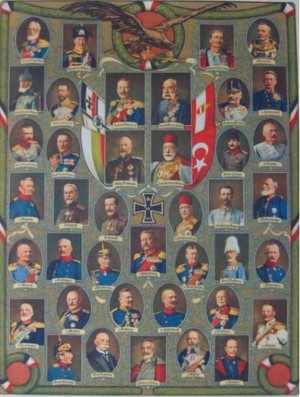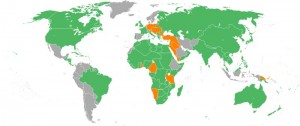 The Central Powers were the enemies of the United States and its allies in World War I. This alliance initially consisted of four nations: Germany, the Austrian-Hungarian Empire, the Ottoman Empire and the Kingdom of Bulgaria. The name is derived from the geographic position of the member nations in the central region of Europe.
The Central Powers were the enemies of the United States and its allies in World War I. This alliance initially consisted of four nations: Germany, the Austrian-Hungarian Empire, the Ottoman Empire and the Kingdom of Bulgaria. The name is derived from the geographic position of the member nations in the central region of Europe.
The Triple Entente
When the First World War flared to life in 1914, the immediate enemies of the Central Powers were known collectively as the “Triple Entente.” These were the nations of Great Britain, France, and Russia. The United States would later join the Triple Entente in the war against the Central Powers.
Italy Opts Out
Italy was originally an ally of Germany as the war began, but because of complex political complications, it opted out of supporting Germany and the Triple Alliance in World War I. For one thing, Italy was a provisional member of the Triple Alliance, but only in terms of a defense pact.
Germany and its partners were seen as the aggressors in the First World War, causing Italy to sit out. Italy also had secret nonaggression pacts with France and the United Kingdom.
A Loose Bond
 The bond between the members of the Central Powers was always somewhat vague and strained. It was a situation in which many lines were blurred. The Ottoman Empire, for example, was less concerned about the ambitions of Germany than it was in settling an old score against the Russians, while at the same time, propping up its crumbling hold on power in the region.
The bond between the members of the Central Powers was always somewhat vague and strained. It was a situation in which many lines were blurred. The Ottoman Empire, for example, was less concerned about the ambitions of Germany than it was in settling an old score against the Russians, while at the same time, propping up its crumbling hold on power in the region.
The Austrian-Hungarian Empire was primarily concerned with going to war and conquering its arch enemy, Serbia. Serbia, in turn, had been a longtime ally of Russia. These two nations share a similar Slavic culture and historically had been aligned for centuries. Even so, Serbia had long-ago been conquered by the Ottoman Empire and was eager to free itself. Thus, an alliance with Russia was in Serbia’s best interest.
Architect of the Central Powers
A historian name German Chancellor Otto von Bismarck was the man who cobbled together the alliance that would became the Central Powers. Part of the reason he selected the Austrian-Hungarian Empire and the Ottomans was to prevent a two-front war.
With the Ottoman Empire harassing the Russians, the Germans could concentrate their efforts on defeating the powerful nations of France and Great Britain.
The Ottoman Empire was once the mightiest entity in Eastern Europe and central Asia, but by the time the war broke out in 1914, it was already well on its way to dissolution. The Ottoman rulers viewed an alliance with Germany and Austria-Hungary as a last chance to retain control over its once far-flung empire.
The war went badly for the Central Powers. Germany and its allies were utterly defeated in a devastating conflict that killed more than 10 million people. The entrance of more than four million American troops into the Great War was more than enough to tip the balance in favor of the Western nations. The Central Powers were shattered.
The Aftermath of War
The Ottoman Empire limped along for several more years before dissolving in 1923. Germany was reduced to a desperate state in the wake of World War I, but the humiliating defeat it suffered would plant the seeds for the rise of an even more virulent, warlike state – the Third Reich – led my Adolf Hitler.
The Austrian-Hungarian Empire collapsed under the weight of the war in August of 1918, just months before the end of “The Greatest War.”